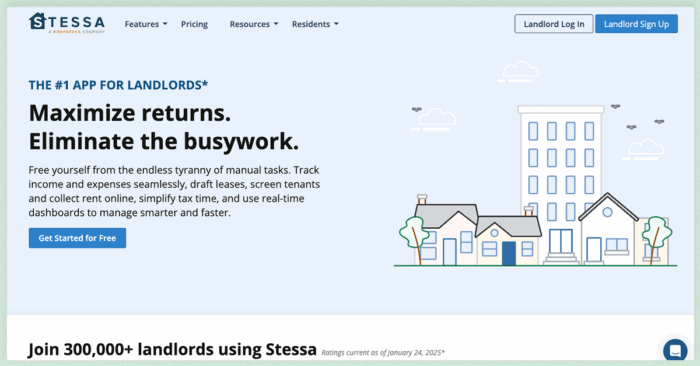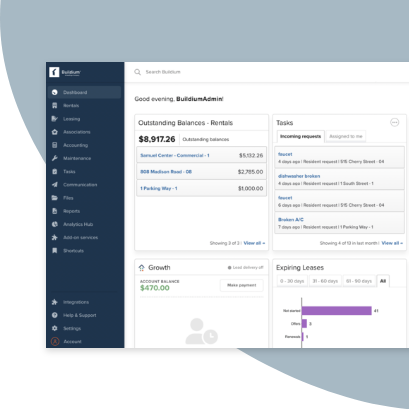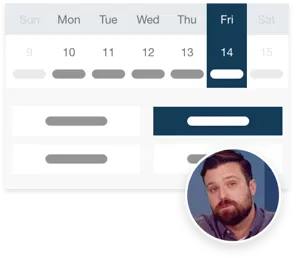Managing residential rental properties in 2026 comes with a growing list of expectations. Renters want quick responses, online payments, and a hassle-free leasing process. To keep up, landlords and property managers are turning to software that helps them automate tasks, stay organized, and grow their businesses.
Two widely used solutions in today’s market are Buildium and Stessa. On the surface, both offer tools for managing leases, collecting rent, and tracking income and expenses. But dig deeper, and you’ll find a stark difference in who these platforms are built for.
In this detailed guide, we’ll walk you through a full comparison of Buildium vs Stessa—from features and pricing to integrations and support. By the end, you’ll know exactly which platform is right for your business in 2026.
Buildium at a Glance

Buildium is a comprehensive property management platform designed for residential property management and association management companies of all sizes—from solo managers to large firms. It covers nearly every aspect of property management, including leasing, rent collection, maintenance tracking, and accounting. Buildium stands out for its ability to grow with your business. Whether you’re managing 10 units or 10,000, it keeps your operations organized and under control.
Features
Buildium offers a robust suite of features purpose-built for professional property management:
- Accounting tools, including general ledger, budgeting, automated bank reconciliation, and 1099 eFiling
- Online leasing tools with customizable templates, eSignature, and application screening
- Tenant and owner portals for communication, payments, and transparency
- Maintenance coordination, including work order tracking, vendor management, and mobile accessibility
- Marketing tools with listing syndication, a free website builder, and built-in lead tracking
- Revenue generation features, such as resident insurance, tenant-paid application fees, and late fee automation
- Mobile apps for managers, tenants, and owners
- Marketplace integrations and an open API for seamless access for third-party tool connections and the ability to set up custom workflows
- Dedicated support, onboarding, and optional premium services for larger portfolios
- Lumina AI, a collection of tools powered by agentic AI that feels like having more hands to support routine tasks such as tenant communication, maintenance coordination
- Workflow automations that trigger approvals and updates automatically, reducing delays and human error
Pricing
Buildium offers three pricing tiers: Essential, Growth, and Premium. Each tier unlocks progressively advanced features, with pricing typically based on unit count. Here’s more details on each of the three tiers:
Essential: Starting at $62/month, Essential includes Buildium’s core features and is geared toward property management companies who are looking for accounting and task management tools.
Growth: Starting at $192/month, Growth is the plan for property managers looking to grow without worrying about scaling costs. It includes unlimited eSignatures, and actionable insights in Analytics Hub.
Premium: Starting at $400/month, this plan is meant for property management businesses who want full access to everything Buildium has to offer with greater customization and automation. It includes everything in Growth, plus access to Buildum’s Open API and Priority Support.
While Buildium is not free, its pricing reflects a scalable solution for professional managers who need reliable tools, audit-grade accounting, and strong compliance support.
Stessa at a Glance

Stessa was built with the independent landlord and real estate investor in mind. Its easy-to-use platform focuses on tracking financial performance, offering property insights, and handling basic management tasks. With Stessa, landlords can monitor cash flow, automate income and expense tracking, and create financial reports. It also includes tools such as rent collection, document storage, and basic maintenance logging, but its main strength is in helping users understand the financial side of their rentals.
Stessa is part of Roofstock, a real estate tech company known for its marketplace of turnkey single-family rentals. This connection shows in Stessa’s finance-first design. It’s a great match for landlords who care most about tracking returns and making informed investment decisions.
Features
Stessa’s primary focus is on financial visibility and performance tracking. It includes:
- Expense and income tracking with bank account integrations
- Basic rent collection tools
- Financial dashboards and document storage
- Tax packages including Schedule E export and mileage tracking
- Basic lease tracking and reminders
- Limited maintenance tracking
- An owner dashboard for portfolio performance insights
- Mobile app with expense scanning
Stessa’s strength is its simplicity and free entry point—perfect for landlords with a few units, but not suited for companies that manage for others or require operational automation.
Stessa Pricing
Stessa offers a free version with core financial tracking tools, plus a “Manage” plan and “Pro” plan (approximately $12/month and $28/ month respectively, when paid annually) that adds more advanced features such as rent collection, eSign, and smart categorization.
Even the Pro plan remains landlord-oriented and lacks many of the operational features a property management company would need at scale. However, each plan’s cost and features can always change so be sure to check out the company’s pricing page here.
Features to Look for in Property Management Software
When choosing property management software, certain features can have an outsized impact on your daily operations and long-term growth. Here’s what to look out for:
Accounting
Strong accounting features form the foundation of any reliable property management platform. Managers need tools that accurately track rent payments, expenses, and deposits while keeping owner and tenant funds separate. Look for features such as trust accounting, bank reconciliations, and the ability to create detailed financial reports. These tools help maintain compliance and provide a clear view of how each property is performing.
Tax preparation is another big part of the accounting puzzle. Good software can simplify year-end processes by generating 1099 forms, Schedule E reports, and P&L summaries automatically. For those managing multiple owners or investor groups, the ability to produce customized statements and automate distributions makes tax season much easier to handle.
Leasing Tools
Leasing tools help property managers fill vacancies faster and reduce manual work. A solid leasing feature set includes customizable lease templates, online applications, background checks, and electronic signatures. These tools remove bottlenecks from the leasing cycle and help teams move tenants in quickly without bouncing between systems.
Automation plays a big role here. When leasing software ties directly into applicant screening, digital document storage, and rent collection, it reduces the chance for errors and cuts the time it takes to complete each lease. Tenants also benefit by having a more convenient experience from the moment they apply to the day they get their keys.
Maintenance Tools
Keeping properties in good shape means handling maintenance requests efficiently. Maintenance tools should let tenants submit work orders online, include photos, and track status updates. Property managers can assign tasks to vendors, add notes, and keep everything logged for future reference.
Some platforms also allow you to create vendor profiles, set spending limits, and review past work. These features help managers stay organized and avoid surprises. Over time, having a maintenance record for each unit helps with budgeting and can even reveal patterns or recurring issues that need to be addressed.
Marketing Tools
Marketing features help fill units faster and keep occupancy rates high. Look for software that lets you create and post listings directly to websites such as Apartments.com, Zillow, and Craigslist. This saves time and makes it easier to keep listings up to date.
Some platforms also include tools for branding your company and tracking how listings perform. Being able to monitor traffic, adjust pricing, and test descriptions or images can make a serious difference in how fast you attract qualified tenants. Having built-in marketing tools also reduces the need for third-party platforms.
Communication Tools
Clear communication keeps tenants and owners informed and reduces misunderstandings. A good platform lets you send updates through email, text, or in-app messages. Tenants can get reminders about rent, maintenance, or lease renewals, while owners receive financial summaries and important updates.
Centralized communication also makes documentation easier. When all messages are saved in one place, you can quickly reference past conversations if disputes arise. Plus, professional communication tools help you deliver a better customer experience.
Mobile Apps
Mobile-friendly software helps you and your tenants manage tasks on the go. A strong mobile app should support rent payments, maintenance requests, document uploads, and tenant screening. This makes it easier for property managers to stay responsive, even outside the office.
For tenants, the convenience of handling payments and service requests from their phones improves satisfaction. Many renters now expect a modern, app-based experience—so having a reliable mobile interface can be a major selling point.
Integration with Other Software
Software integrations allow your property management tools to connect with accounting systems, CRMs, marketing platforms, and more. Platforms with open APIs and app marketplaces make it easier to build a workflow that fits your business.
Instead of juggling disconnected tools, you can bring everything together in one ecosystem. This saves time, reduces data entry errors, and helps your team work more efficiently. For businesses with unique needs, integration flexibility can be a deciding factor when choosing software.
Stessa vs Buildium: Pricing
Buildium’s pricing reflects its position as a full-featured option for professional managers. The monthly fee can be higher than basic tools, but it’s often worth it for the wide range of features and automation. Its clear pricing tiers include features such as owner portals, maintenance tracking, and complete accounting, even at the base level.
Stessa is more affordable and geared toward landlords and small investors who want to keep costs low. The free version has a lot to offer, but doesn’t include tools for more complex needs. Stessa Pro adds some valuable upgrades, but the platform works best for simpler portfolios and financial-focused landlords.
Stessa vs Buildium: Property Management Accounting
Accounting is one of Buildium’s biggest strengths. It supports full double-entry accounting for property managers, including trust accounting, owner draws, reconciliations. You can track every dollar at the unit, property, or portfolio level, which is especially helpful when managing funds for multiple clients or associations. You can also prep your documents far ahead of tax season with Buildium’s 1099 efiling features.
Stessa isn’t as detailed when it comes to traditional property management accounting, but it shines in investment tracking. Its real-time dashboards, automatic transaction categorization, and strong reporting tools make it a great fit for landlords focused on tax prep and cash flow. However, it doesn’t offer trust accounting or the same level of financial detail that professional managers often need.
Stessa vs Buildium: Online Rent and Fee Collection
Collecting rent and fees online is standard practice in 2025. Tenants expect mobile-friendly options to make payments, while property managers want tools that reduce delays and keep cash flow steady. Buildium delivers with features that include automated recurring payments, late fee scheduling, and real-time tracking. Payments route securely and can be split by property or owner. Tenants get reminders, and managers see payment status updates instantly.
Stessa offers basic online rent collection through a user-friendly interface. Landlords can accept payments via ACH or debit, and the platform automatically logs transactions. However, it doesn’t support custom fee structures or late payment automation. This setup works well for small portfolios, but those managing more units may feel boxed in as they grow.
Stessa vs Buildium: Communication Portals
Buildium offers robust portals for both tenants and owners. These portals make it easy to send messages, pay rent, request maintenance, and access documents. Owners can view reports and property updates, while tenants can handle most of their rental tasks online. These features make communication more efficient and help build trust.
Stessa’s portals are simpler and mostly focus on financial visibility and rent payments. They work well for individual landlords with a few properties but may feel limited for those managing more tenants or needing deeper communication tools.
Stessa vs Buildium: Property Maintenance Management
Managing maintenance effectively keeps tenants happy and protects property value. Buildium lets tenants submit detailed requests via the portal or app, including photos. Property managers can assign tasks to vendors, monitor progress, and track service histories, even allowing for project-level management.
The platform allows categorizing, prioritizing, and commenting on each work order, which is especially helpful for teams juggling multiple properties. Managers can also store vendor details, including licenses and payment preferences. You can even offer tenants 24/7/365 service with the Maintenance Contact Center.
Stessa includes a simple tool for logging maintenance issues, but it lacks built-in coordination features. Landlords can take notes but cannot assign tasks, communicate with vendors, or maintain a service history. It works for smaller portfolios, but larger operations need the more complete toolset Buildium provides.
Stessa vs Buildium: Rental Applications and Tenant Screening
A solid leasing process starts with easy applications and reliable screening. Buildium offers a customizable rental applications that connect directly to its broader suite of applicant tracking capabilities. Integrated screening tools deliver background checks, credit reports, eviction histories, and income verification in one place. This setup saves time and helps landlords find the right tenants faster. Buildium’s tenant screening is also backed by TransUnion, making it reliable and easy to find qualified renters faster.
Stessa also supports tenant screening, but it’s more limited. Landlords can request credit and background checks through third-party services, though the process isn’t fully integrated. For a handful of units, this approach may be enough. But those with multiple listings will likely prefer Buildium’s more connected experience.
Stessa vs Buildium: Online Renting and eSign
Buildium supports digital leasing from start to finish. Property managers can customize lease templates, send them for eSignatures, and store them securely. The system handles multiple signers and tracks activity for compliance. Everything stays in one place, cutting down on email chains and paper forms.
Stessa allows for document sharing and basic eSigning that are ideal for individual landlords handling smaller volumes of documents.
Stessa vs Buildium: Revenue Generation and Growth Tools
Great property management software does more than manage—it helps your business grow. Buildium supports revenue generation with custom fees, potential resident and owner benefit packages (through marketplace partners), and other services such as property and renters insurance. Managers can apply pet rent, amenity charges, and renewal fees based on rules they define. With advanced data and analytics tools, you can fine tune all types of performance, whether that’s upkeep for a specific unit, or investment to grow an entire portfolio.
Stessa focuses on financial insights. Landlords can use performance reports to spot underperforming properties and track long-term value. While useful, the platform does not offer tools that actively drive revenue growth or help scale a property management business.
Stessa vs Buildium: Integrations and API Access
Buildium offers flexible integrations and customization through the Buildium Marketplace and its open API. Managers can connect Buildium with dozens of tools such as LesdSimple, HappyCo, and Tenant Turner—just to name a few. For tech-savvy teams, the open API supports custom development to fit specific workflows. Combined, this helps you get more mileage out of the software. It makes features easier to scale and adapt to the direction you schoose to grow your business in. It also gives you a variety of ways to introduce new revenue streams into your service offerings.
Stessa keeps things simpler. It connects to bank accounts and a few third-party tools for taxes and payments, but it doesn’t support wide-ranging integrations or custom development. For larger or growing teams, that could become a roadblock.
Stessa vs Buildium: Showing Coordination
Buildium integrates with showing tools that handle scheduling, calendar sync, and prospect communication. Managers can send confirmations, reduce no-shows, and track leads without switching platforms.
Stessa doesn’t offer showing coordination features. Landlords must set appointments and follow up on their own, often using email or personal calendars.
Stessa vs Buildium: Customer Support
Buildium’s customer support includes chat, email, and phone (for higher-tier plans). Users also get access to webinars, help docs, and extensive resources on Buildium Academy. The team responds quickly and has deep product knowledge, which makes a big difference when managing dozens or hundreds of units.
Stessa offers email support and an online help center, with priority support available to Pro users. It’s responsive but more limited in scope, which may not work as well for users who want faster or more hands-on help.
Stessa vs Buildium: Final Thoughts
Both platforms serve different types of users. Buildium works well for property managers aiming to grow, thanks to its rich features and flexibility. It helps businesses stay organized, respond faster, and offer a professional experience for owners and tenants.
Stessa, on the other hand, fits independent landlords or investors focused on tracking performance and managing a few units. It’s straightforward and budget-friendly but not designed for high-volume operations.
If you’re looking for more comprehensive property management software that’s geared toward growth minded property managers of all sizes, Buildium is an excellent choice—but never go into a buying decision blind. You can try out Buildium for yourself with a 14-day, free trial or by scheduling a personalized demo today.
Frequently Asked Questions
What is property management software?
Property management software centralizes leasing, rent collection, maintenance, and accounting tasks in one platform. It automates routine work to save time for landlords and property managers.
Do I need property management software?
Yes, if you manage more than five units or plan to grow your portfolio. The software saves time and improves tenant satisfaction.
Are there drawbacks to property management software?
Some platforms can be too complex or expensive for landlords with smaller portfolios. There might be a learning curve, and not every feature will apply to your situation. But for most managers, the time savings and organization are worth it.
How do I get the most value from property management software?
Start with a platform that matches your portfolio size, then set up key automations for rent collection and maintenance. Use reporting features to track performance and improve operations.
Buildium’s Commitment to Safe and Secure AI
At Buildium, we believe that AI should be a trusted extension of our platform–not a replacement for human judgement. Our approach to AI is grounded in transparency, education, and rigorous security standards. We deploy AI features with a clear focus: to automate routine tasks while preserving the integrity of sensitive decisions that require human oversight. Lumina AI is built for property managers who value efficiency, security, and trust. We’re not just innovating–we’re doing so responsibly.


